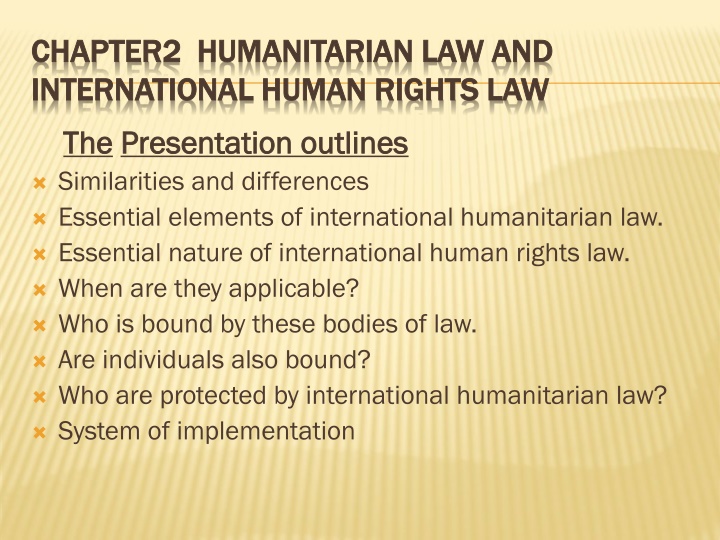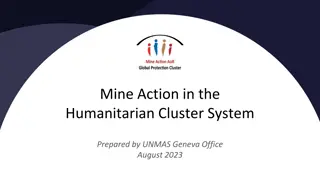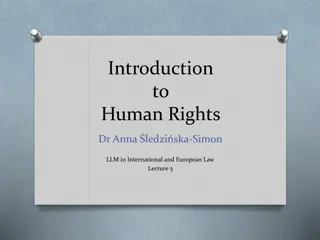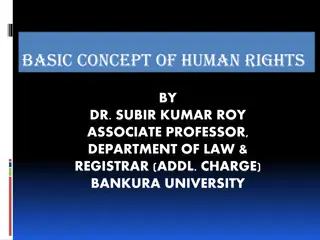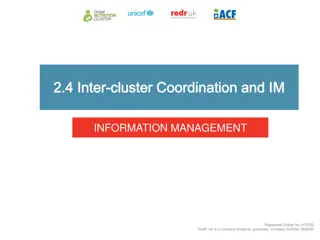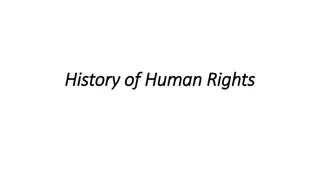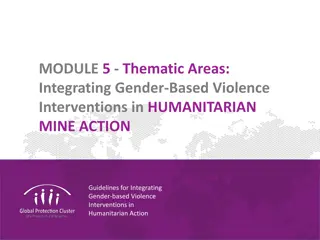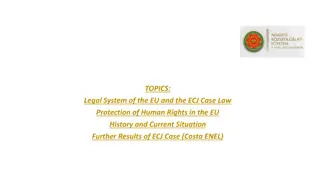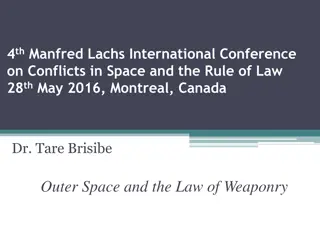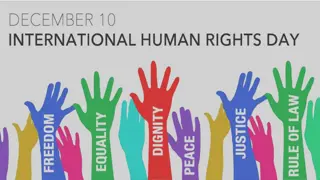International Humanitarian Law vs International Human Rights Law: Essential Elements
International humanitarian law (IHL) and international human rights law (IHRL) aim to protect individuals' lives, health, and dignity from different perspectives. While there are similarities, they also have distinct focuses such as conduct of hostilities and peacetime rights. IHL deals with issues like combatant status, while IHRL covers aspects like freedom of the press. Essential elements of IHL include rules established by treaty to address humanitarian issues arising from armed conflicts, protecting individuals and property affected by conflict.
Download Presentation

Please find below an Image/Link to download the presentation.
The content on the website is provided AS IS for your information and personal use only. It may not be sold, licensed, or shared on other websites without obtaining consent from the author.If you encounter any issues during the download, it is possible that the publisher has removed the file from their server.
You are allowed to download the files provided on this website for personal or commercial use, subject to the condition that they are used lawfully. All files are the property of their respective owners.
The content on the website is provided AS IS for your information and personal use only. It may not be sold, licensed, or shared on other websites without obtaining consent from the author.
E N D
Presentation Transcript
CHAPTER CHAPTER2 INTERNATIONAL HUMAN RIGHTS LAW INTERNATIONAL HUMAN RIGHTS LAW 2 HUMANITARIAN LAW AND HUMANITARIAN LAW AND The The Presentation outlines Presentation outlines Similarities and differences Essential elements of international humanitarian law. Essential nature of international human rights law. When are they applicable? Who is bound by these bodies of law. Are individuals also bound? Who are protected by international humanitarian law? System of implementation
SIMILARITIES AND DIFFERENCES International humanitarian law (IHL) and international human rights law (IHRL)strive to protect the lives , health, and dignity of individuals ,albeit from the different angle . It is therefore not surprising that, while very different in formulation ,the essence of some of the rules is similar ,if not identical .
CONT For example ,the two bodies of law aim to protect human life ,prohibit torture or cruel treatment ,prescribe basic rights for persons subject to a criminal justice process , prohibit discrimination, comprise provisions for the protection of women and children , regulate aspects of the right to food and health.
CONT On the other hand , rules of IHL deal with many issues that are outside the purview of IHRL ,such as the conduct of hostilities , combatant and prisoners of war status and the protection of the red cross and red crescent emblems . Similarly, IHRL deals with aspects of life in peacetime that are not regulated by IHL ,such as freedom of the press, the right to assembly, to vote and to strike.
ESSENTIAL ELEMENTS OF INTERNATIONAL ESSENTIAL ELEMENTS OF INTERNATIONAL HUMANITARIAN LAW HUMANITARIAN LAW HL is a set of international rules, established by treaty or custom, which are specifically intended to solve humanitarian problems directly arising from international or non- international armed conflicts. It protects persons and property that are or may be affected by an armed conflict and limits the rights of the parties to a conflict to use methods and means of warfare of their choice
CONT HL s main treaty sources applicable in international armed conflict are the four Geneva conventions of 1949 and their additional protocol 1 of 1977. The main treaty sources applicable in non-international armed conflict are article 3 common to the Geneva Convention and additional protocol II of 1977.
ESSENTIAL NATURE OF INTERNATIONAL HUMAN ESSENTIAL NATURE OF INTERNATIONAL HUMAN RIGHTS LAW RIGHTS LAW International human rights law (HRL)is a set of international rules, established by treaty or custom, on the basis of which individuals and groups can expect and / or claim certain behavior or benefits from governments.
CONT Human rights are an inherent entitlement which belongs to every person as a consequence of being human.
CONT IHRL main treaty sources are the international Covenants on civil and political rights and on economic, social and cultural rights (1966), as well as conventions on Genocide (1948), Racial Discrimination (1965), Discrimination Against Women (1979), Torture (1984) and rights of child (1989).
CONT The main regional instruments are the European Convention for the protections of Human rights and fundamental freedoms (1950), the American declaration of the rights and duties of man (1948) and convention on human rights (1969), and the African charter on human and peoples rights (1981).
WHEN ARE THEY APPLICABLE? WHEN ARE THEY APPLICABLE? IHL IHL is applicable in ties of armed conflict, whether international or non-international. International conflicts are wars involving two or more states, and wars of liberation, regardless of whether a declaration of war has been made or whether the parties involved recognize that there is a status of war..
CONT Non- international armed conflicts are those in which government forces are fighting against armed insurgents, or rebel groups are fighting among themselves. Because IHL deals with an exceptional situation, armed conflict, no derogations whatsoever from its provisions are permitted.
CONT,,, In principle, IHRL applies at all times, I.e. both in peacetime and in situations of armed conflict. However, some IHRL treaties permit governments to derogate from certain rights in situations of public emergency threatening the life of the nation. Derogations must, however, be proportional to the crisis at hand, must not be introduced on a discriminatory basis and must not contravene other rules of international law including rules of IHL.
CONT Certain human rights are never derogate able. Among them are the right to life, prohibition of torture or cruel, in human or degrading treatment or punishment, prohibition of slavery and the prohibition of retroactive criminal laws.
WHO IS BOUND BY THE BODIES OF LAW? WHO IS BOUND BY THE BODIES OF LAW? IHL binds all actors to an armed conflict: in international conflicts it must be observed by the states involved, whereas in internal conflict it binds the government, as well the groups fighting against it or among themselves. Thus, IHL lays down rules that are applicable to both state and non-state actors.
CONT,,, IHRL lays down rules binding governments in their relations with individuals. While there is a growing body of opinion according to which non-state actor particularly if they exercise government like functions must also be expected to respect human rights norms, he issue remains unsettled t.
ARE INDIVIDUAL ALSO BOUND ARE INDIVIDUAL ALSO BOUND IHL imposes obligations on individuals and also provides that persons may be held individually criminally responsible for grave breaches of the Geneva conventions and additional protocol 1, and for other serious violations of the laws and customs of war (war crimes).
CONT . IHL established universal jurisdiction over persons suspected of having committed all such acts. With the entry into force of the international criminal court, individuals will also be accountable for war crimes committed in non-international armed conflict.
CONT While individuals do not have specific duties under IHRL treaties, IHL also provides for individual criminal responsibility for violations that may constitute international crimes, such as genocide, crimes against humanity and torture. These crimes are also subject to universal jurisdiction.
WHO ARE PROTECTED BY INTERNATIONAL WHO ARE PROTECTED BY INTERNATIONAL HUMANITARIAN LAW? HUMANITARIAN LAW? conventions deal with the treatment of the wounded and sick in the armed forces in the field (convention I), wounded, sick and shipwrecked members of the armed forces at sea (convention II), prisons of war (convention III) and civilian persons (convention IV), civilian persons include internally displaced persons, women, children, refuges, stateless persons, journalists and other categories of individuals (convention IV and protocol I).
CONT Similarly, the rules applicable in non-international armed conflict (article 3 common to the Geneva conventions and protocol II) deal with the treatment of persons not taking, or no longer taking part in the hostilities. IHL also protects civilians through rules on the conduct of hostilities. For example, parties to a conflict must at all times distinguish between combatants and non- combatants and between military and non- military targets. Neither the civilian population a whole nor individual civilians may be the object of attack.
SYSTEM SYSTEM OF OF IMPLEMENTATION IMPLEMENTATION 1 1- -National level National level The duty to implement both IHL and IHRL lies first and foremost with states States have a duty to take a number of legal and practical measures both in peacetime and in armed conflict situations and aimed at ensuring full compliance with IHL, including: Translating IHL treaties;
CONT Preventing and punishing war crimes, through the enactment of penal legislation: Protecting the red cross and red crescent emblems; Applying fundamental and judicial guarantees; Disseminating IHL; Training personnel to be qualified in IHL, and appointing, legal advisers to the armed forces.
2 2- -INTERNATIONAL LEVEL INTERNATIONAL LEVEL As regards international implementation states have a collective responsibility under article 1 common to the Geneva Convention to respect and to ensure respect for the conventions in all circumstances.
REGIONAL LEVEL REGIONAL LEVEL The work of regional human rights courts and commissions established under the main regional human rights treaties in Europe, the American and Africa is a distinct feature of IHRL, with no equivalent in IHL, regional human rights mechanisms are, however, increasingly examining violations of IHL.
